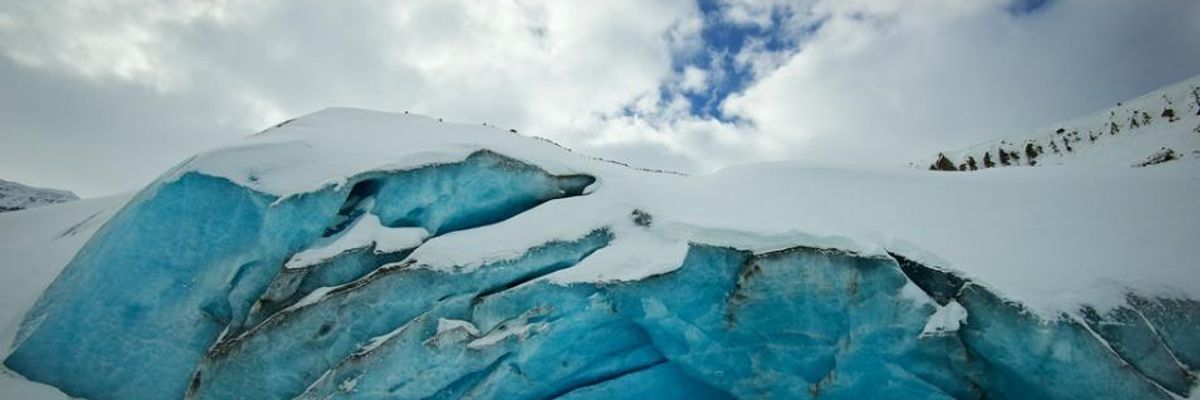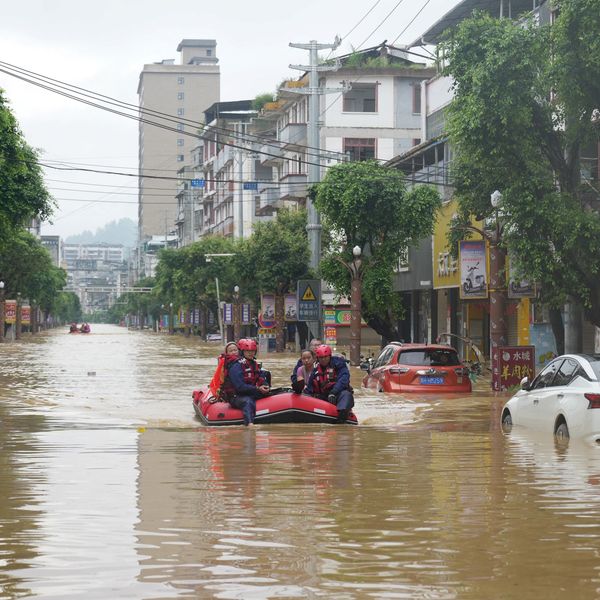
The Athabasca Glacier in Alberta is one of 17,000 glaciers which face a loss of 70 percent by 2100, according to a new report. (Photo: Steve Dunleavy/flickr/cc)
Canada Faces 70 Percent Glacier Loss by 2100
New report finds glacier loss could have profound impact on natural ecosystems and access to drinking water
Canadian glaciers may shrink by 70 percent by the end of the century, a development which could have devastating environmental effects, according to a new report published Monday in Nature Geoscience.
The report, titled Projected Deglaciation of Western Canada in the Twenty-First Century, used digital models of current glaciers and the physics of ice flow, measured against predictions of long-term global warming from the Intergovernmental Panel on Climate Change, to predict how rising greenhouse gases will affect glaciers in that region.
As the New York Times explains, "glaciers in Western Canada will shrink to less than 10 percent of the area they covered in 2005, and glaciers in the coastal regions will be reduced to about 30 percent of their 2005 size."
In the drier interior of the Rocky Mountains, up to 90 percent of the glaciers could be lost. Western Canada is home to more than 17,000 glaciers.
"Few glaciers will remain in the Interior and Rockies regions, but maritime glaciers, in particular those in northwestern British Columbia, will survive in a diminished state," the report states. "Our projected changes of ice cover in western Canada have broader ramifications for aquatic ecosystems, agriculture, forestry, alpine tourism, water quality and resource development."
The loss of glaciers is a major contributing factor to rising sea levels and could also have a profound effect on the survival rates of aquatic animals and the quality and supply of potable water, the researchers state.
"These glaciers act as a thermostat for freshwater ecosystems," lead author and University of British Columbia professor emeritus Garry Clarke said in a press release Monday. "Once the glaciers are gone, the streams will be a lot warmer and this will hugely change fresh water habitat. We could see some unpleasant surprises in terms of salmon productivity."
Clarke told the Times, "The glaciers don't respond to weather; they respond to climate. Last year's bad winter is not going to save the glaciers. On average, climate is changing, and it's not changing in ways that are good for glacier survival. And it's not good for a lot of other things, including California water."
What's more, the report's findings are "a conservative scenario," Clarke told the Washington Post on Tuesday. "All the others [models] lead to total loss of ice in the mountains there."
Andreas Vieli, corresponding author and a professor of geography at the University of Zurich, said the report's analysis could "potentially be applied to a wide range of glacierized regions" around the world.
Clarke highlighted the importance of reducing humanity's carbon footprint to battle the lasting effects of climate change, on the glaciers and elsewhere.
"We have to have a peak occur in the mid-2040s so carbon dioxide is on downward path hereafter," Clarke told the Post. "We don't have a lot of time to get there."
An Urgent Message From Our Co-Founder
Dear Common Dreams reader, The U.S. is on a fast track to authoritarianism like nothing I've ever seen. Meanwhile, corporate news outlets are utterly capitulating to Trump, twisting their coverage to avoid drawing his ire while lining up to stuff cash in his pockets. That's why I believe that Common Dreams is doing the best and most consequential reporting that we've ever done. Our small but mighty team is a progressive reporting powerhouse, covering the news every day that the corporate media never will. Our mission has always been simple: To inform. To inspire. And to ignite change for the common good. Now here's the key piece that I want all our readers to understand: None of this would be possible without your financial support. That's not just some fundraising cliche. It's the absolute and literal truth. We don't accept corporate advertising and never will. We don't have a paywall because we don't think people should be blocked from critical news based on their ability to pay. Everything we do is funded by the donations of readers like you. The final deadline for our crucial Summer Campaign fundraising drive is just days away, and we’re falling short of our must-hit goal. Will you donate now to help power the nonprofit, independent reporting of Common Dreams? Thank you for being a vital member of our community. Together, we can keep independent journalism alive when it’s needed most. - Craig Brown, Co-founder |
Canadian glaciers may shrink by 70 percent by the end of the century, a development which could have devastating environmental effects, according to a new report published Monday in Nature Geoscience.
The report, titled Projected Deglaciation of Western Canada in the Twenty-First Century, used digital models of current glaciers and the physics of ice flow, measured against predictions of long-term global warming from the Intergovernmental Panel on Climate Change, to predict how rising greenhouse gases will affect glaciers in that region.
As the New York Times explains, "glaciers in Western Canada will shrink to less than 10 percent of the area they covered in 2005, and glaciers in the coastal regions will be reduced to about 30 percent of their 2005 size."
In the drier interior of the Rocky Mountains, up to 90 percent of the glaciers could be lost. Western Canada is home to more than 17,000 glaciers.
"Few glaciers will remain in the Interior and Rockies regions, but maritime glaciers, in particular those in northwestern British Columbia, will survive in a diminished state," the report states. "Our projected changes of ice cover in western Canada have broader ramifications for aquatic ecosystems, agriculture, forestry, alpine tourism, water quality and resource development."
The loss of glaciers is a major contributing factor to rising sea levels and could also have a profound effect on the survival rates of aquatic animals and the quality and supply of potable water, the researchers state.
"These glaciers act as a thermostat for freshwater ecosystems," lead author and University of British Columbia professor emeritus Garry Clarke said in a press release Monday. "Once the glaciers are gone, the streams will be a lot warmer and this will hugely change fresh water habitat. We could see some unpleasant surprises in terms of salmon productivity."
Clarke told the Times, "The glaciers don't respond to weather; they respond to climate. Last year's bad winter is not going to save the glaciers. On average, climate is changing, and it's not changing in ways that are good for glacier survival. And it's not good for a lot of other things, including California water."
What's more, the report's findings are "a conservative scenario," Clarke told the Washington Post on Tuesday. "All the others [models] lead to total loss of ice in the mountains there."
Andreas Vieli, corresponding author and a professor of geography at the University of Zurich, said the report's analysis could "potentially be applied to a wide range of glacierized regions" around the world.
Clarke highlighted the importance of reducing humanity's carbon footprint to battle the lasting effects of climate change, on the glaciers and elsewhere.
"We have to have a peak occur in the mid-2040s so carbon dioxide is on downward path hereafter," Clarke told the Post. "We don't have a lot of time to get there."
Canadian glaciers may shrink by 70 percent by the end of the century, a development which could have devastating environmental effects, according to a new report published Monday in Nature Geoscience.
The report, titled Projected Deglaciation of Western Canada in the Twenty-First Century, used digital models of current glaciers and the physics of ice flow, measured against predictions of long-term global warming from the Intergovernmental Panel on Climate Change, to predict how rising greenhouse gases will affect glaciers in that region.
As the New York Times explains, "glaciers in Western Canada will shrink to less than 10 percent of the area they covered in 2005, and glaciers in the coastal regions will be reduced to about 30 percent of their 2005 size."
In the drier interior of the Rocky Mountains, up to 90 percent of the glaciers could be lost. Western Canada is home to more than 17,000 glaciers.
"Few glaciers will remain in the Interior and Rockies regions, but maritime glaciers, in particular those in northwestern British Columbia, will survive in a diminished state," the report states. "Our projected changes of ice cover in western Canada have broader ramifications for aquatic ecosystems, agriculture, forestry, alpine tourism, water quality and resource development."
The loss of glaciers is a major contributing factor to rising sea levels and could also have a profound effect on the survival rates of aquatic animals and the quality and supply of potable water, the researchers state.
"These glaciers act as a thermostat for freshwater ecosystems," lead author and University of British Columbia professor emeritus Garry Clarke said in a press release Monday. "Once the glaciers are gone, the streams will be a lot warmer and this will hugely change fresh water habitat. We could see some unpleasant surprises in terms of salmon productivity."
Clarke told the Times, "The glaciers don't respond to weather; they respond to climate. Last year's bad winter is not going to save the glaciers. On average, climate is changing, and it's not changing in ways that are good for glacier survival. And it's not good for a lot of other things, including California water."
What's more, the report's findings are "a conservative scenario," Clarke told the Washington Post on Tuesday. "All the others [models] lead to total loss of ice in the mountains there."
Andreas Vieli, corresponding author and a professor of geography at the University of Zurich, said the report's analysis could "potentially be applied to a wide range of glacierized regions" around the world.
Clarke highlighted the importance of reducing humanity's carbon footprint to battle the lasting effects of climate change, on the glaciers and elsewhere.
"We have to have a peak occur in the mid-2040s so carbon dioxide is on downward path hereafter," Clarke told the Post. "We don't have a lot of time to get there."

